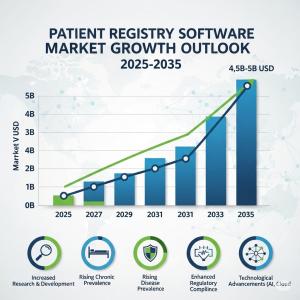Patient Registry Software Market Projected to Reach USD 5.7 Billion by 2035, Driven by Healthcare’s Digital Innovation
The Patient Registry Software Market is expanding rapidly, driven by the healthcare industry’s shift toward digital innovation and data-driven solutions.
NEWARK, DE, UNITED STATES, August 6, 2025 /EINPresswire.com/ — The Patient Registry Software Market is entering a transformative growth phase, expected to surge from USD 2.4 billion in 2025 to USD 5.7 billion by 2035, advancing at a compound annual growth rate (CAGR) of 8.8%. This anticipated growth is fueled by the increasing integration of electronic health records (EHRs), widespread healthcare digitization efforts, and global demand for robust data-driven clinical and public health systems.
With chronic disease management, personalized care, and regulatory compliance becoming pressing concerns, patient registry software is quickly becoming a cornerstone of modern healthcare infrastructure. It offers a strategic solution to manufacturers, healthcare organizations, and public institutions seeking scalable, interoperable platforms that bridge data gaps and unlock actionable insights.
Government-Led Growth and Public Domain Dominance
A defining trend in the market is the dominance of public domain registry software, which accounted for 56.8% of the market in 2025. Public health institutions and regulatory bodies across the globe are leading the charge, deploying national registries to enhance chronic disease tracking, monitor population health outcomes, and optimize resource allocation.
These platforms are particularly critical in developing and middle-income countries, where fragmented health systems are being unified through digital public infrastructure. The push toward open-access databases is further facilitating international research collaborations and accelerating cross-border disease surveillance.
The sustained investments by governments in public health modernization, coupled with integration efforts involving national data networks, are expected to cement the public domain segment’s position throughout the forecast period.
Diabetes Takes the Lead in Disease-Based Registries
Within the disease area segmentation, diabetes registries hold the top spot, commanding 32.7% of the market. The global diabetes burden continues to rise, prompting governments and private entities to develop long-term care models anchored in data. These registries not only track patient outcomes and comorbidities but also enable personalized care pathways through AI integration and remote monitoring.
Increased utilization of wearable health technologies and cloud-connected platforms has made real-time data collection possible, empowering patients to manage their health while enabling providers to intervene promptly. This segment is forecasted to continue its expansion, propelled by the need for sustainable chronic care management and advancements in digital therapeutics.
EHR Integration and Regulatory Momentum Fuel Market Expansion
The integration of EHRs into clinical workflows continues to be a primary growth driver. Regulatory frameworks like the U.S. Cures Act have emphasized interoperability and innovation, encouraging health systems to adopt smarter, more accessible data solutions.
The inclusion of AI-driven features such as voice recognition and predictive analytics is reshaping how patient data is accessed and used. These tools allow healthcare providers to retrieve and interpret patient records more efficiently, resulting in improved care delivery and streamlined decision-making.
Cloud-Based Solutions Unlock New Opportunities
The rise of cloud-based EHR and registry systems presents substantial opportunities, especially for small and mid-sized providers. These systems offer lower installation and maintenance costs, broader accessibility, and faster deployment compared to legacy client-server models.
With the ability to facilitate real-time data sharing between institutions and eliminate costly infrastructure investments, cloud-based platforms are set to drive future adoption. As the healthcare ecosystem becomes increasingly interconnected, the demand for agile, remotely accessible software is growing rapidly.
Security and Legacy Systems Pose Challenges
Despite the promising outlook, the market faces headwinds. Data privacy and security remain significant concerns, particularly in light of rising cyberattacks targeting health systems. In April 2025, GHT Coeur Grand Est Hospitals in France experienced a major data breach, leading to a complete shutdown of digital systems and raising alarms about system vulnerabilities.
Moreover, the continued reliance on paper-based registries, especially in rural and under-resourced areas, presents an adoption barrier. A lack of technical expertise and capital investment has slowed digital transitions in some regions, underscoring the need for scalable and cost-effective solutions.
Regional Outlook: North America and APAC Lead
North America, particularly the United States, is set to maintain market leadership with a CAGR of 9.5%. The region’s mature healthcare ecosystem, coupled with supportive policies and a growing burden of chronic diseases, continues to attract substantial investment.
In Asia-Pacific, countries like China (10.5% CAGR) and Japan (9%) are emerging as high-growth markets. Strategic government initiatives, rapid digitization of healthcare systems, and increasing medical tourism are contributing to regional expansion.
India and South Korea are also on the radar, with governments investing in AI-driven registry tools to improve diagnostics and population health monitoring. In South Korea, a USD 1.6 million investment in AI health systems underscores the momentum building across the APAC region.
Request Patient Registry Software Market Draft Report – https://www.futuremarketinsights.com/reports/sample/rep-gb-14633
For more on their methodology and market coverage, visit https://www.futuremarketinsights.com/about-us.
Competitive Landscape: Partnerships and Product Evolution
Key market participants include Dacima Software Inc., IQVIA, Evado eClinical Solutions, Global Vision Technologies Inc., and Invitae. Companies are actively pursuing strategic collaborations to expand capabilities:
In March 2024, ESO Solutions partnered with Virginia EMS Systems to launch a trauma registry.
IQVIA acquired the remaining stake in Q2 Solutions in April 2024 to bolster diagnostic insights.
ImageTrend Inc. updated its Patient Registry with the latest NTDB Data Dictionary in December 2024.
ArborMetrix Inc. joined forces with the Society of Interventional Radiology in June 2024 to deliver analytics-enabled registry solutions.
As regulatory compliance, healthcare innovation, and personalized medicine reshape the industry, the patient registry software market presents a lucrative opportunity for manufacturers seeking long-term growth through next-generation digital solutions.
Explore more insights in our related industry reports.
Patient Positioning System Market
https://www.futuremarketinsights.com/reports/patient-positioning-system-market
Patient Identification Wristbands Market
https://www.futuremarketinsights.com/reports/patient-identification-wristbands-market
Patient Hygiene Aids Market
https://www.futuremarketinsights.com/reports/patient-hygiene-aids-market
Editor Notes
The Patient Registry Software market is experiencing significant growth, primarily driven by the increasing prevalence of chronic and rare diseases, a greater emphasis on value-based care, and the rising demand for real-world evidence (RWE) to inform clinical and regulatory decisions. Key market drivers include government initiatives to digitize healthcare, the widespread adoption of electronic health records (EHRs), and the integration of advanced technologies like AI, machine learning, and cloud-based platforms for improved data analysis and accessibility.
Rahul Singh
Future Market Insights Inc.
+1 347-918-3531
email us here
Legal Disclaimer:
EIN Presswire provides this news content “as is” without warranty of any kind. We do not accept any responsibility or liability
for the accuracy, content, images, videos, licenses, completeness, legality, or reliability of the information contained in this
article. If you have any complaints or copyright issues related to this article, kindly contact the author above.
![]()


